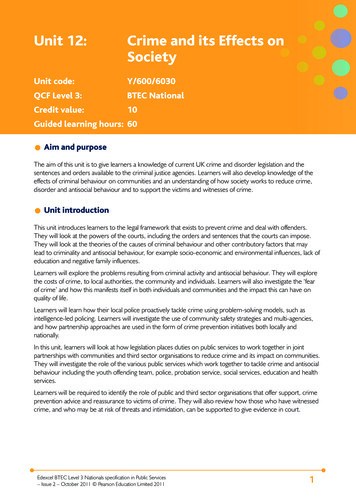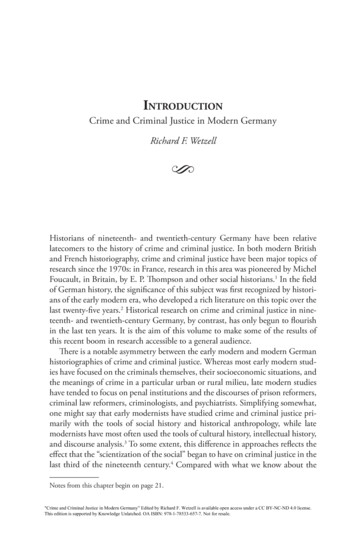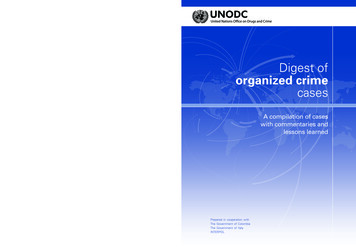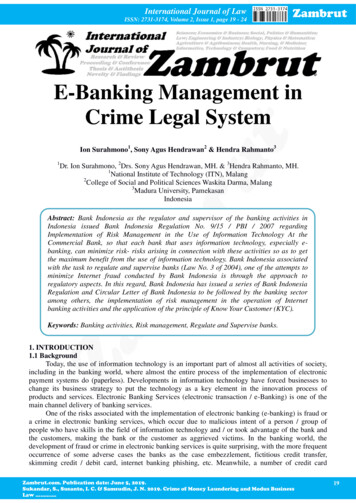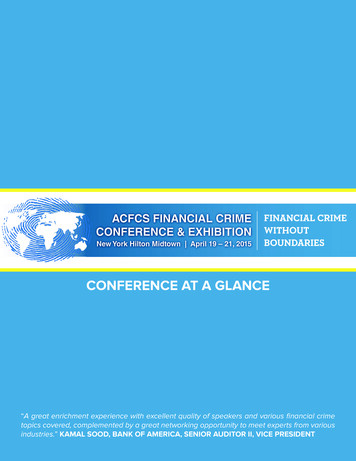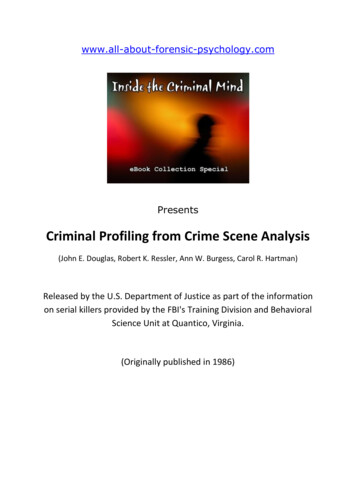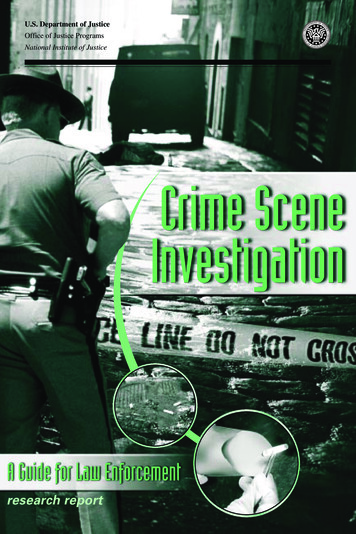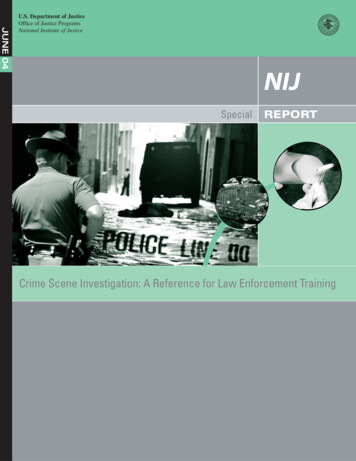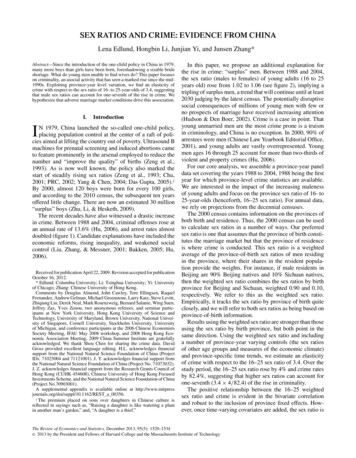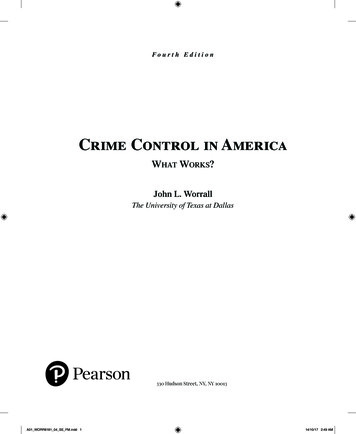
Transcription
Fo u r t h E d i t i o nCrime Control in AmericaWhat Works?John L. WorrallThe University of Texas at Dallas330 Hudson Street, NY, NY 10013A01 WORR8181 04 SE FM.indd 114/10/17 2:49 AM
Vice President, Portfolio Management: Andrew GilfillanPortfolio Manager: Gary BauerEditorial Assistant: Lynda CramerSenior Vice President, Marketing: David GesellField Marketing Manager: Bob NisbetProduct Marketing Manager: Heather TaylorDirector, Digital Studio and Content Production:Brian HylandManaging Producer: Cynthia ZonneveldManaging Producer: Jennifer SargunarContent Producer: Rinki KaurManager, Rights Management: Johanna BurkeOperations Specialist: Deidra SmithCreative Digital Lead: Mary SienerManaging Producer, Digital Studio: Autumn BensonContent Producer, Digital Studio: Maura BarclayCover Designer: Studio MontageCover Images:Full Service Project Management: Abinaya RajendranComposition: Integra Software Services, Ltd.Text Printer/Bindery: LSC Communications, Inc.Cover Printer: Phoenix Color/HagerstownText Font: TimesLTPro-RomanCopyright 2019, 2015, 2008, by Pearson Education, Inc. or its affiliates. All Rights Reserved. Manufactured inthe United States of America. This publication is protected by copyright, and permission should be obtained from thepublisher prior to any prohibited reproduction, storage in a retrieval system, or transmission in any form or by anymeans, electronic, mechanical, photocopying, recording, or otherwise. For information regarding permissions, requestforms, and the appropriate contacts within the Pearson Education Global Rights and Permissions department, please s of third-party content appear on the appropriate page within the text. PEARSON and ALWAYSLEARNING are exclusive trademarks owned by Pearson Education, Inc. or its affiliates in the U.S. and/or other countries.Unless otherwise indicated herein, any third-party trademarks, logos, or icons that may appear in this work are the propertyof their respective owners, and any references to third-party trademarks, logos, icons, or other trade dress are for demonstrative or descriptive purposes only. Such references are not intended to imply any sponsorship, endorsement, authorization, or promotion of Pearson’s products by the owners of such marks, or any relationship between the owner and PearsonEducation, Inc., authors, licensees, or distributors.Library of Congress Cataloging-in-Publication DataNames: Worrall, John L., author.Title: Crime control in America: what works?/John L. Worrall,The University of Texas at Dallas.Description: Fourth Edition. Hoboken: Pearson, [2019] Revised edition of the author’s Crime control in America, [2015]Identifiers: LCCN 2017040408 ISBN 9780134848181 (alk. paper)Subjects: LCSH: Criminal justice, Administration of—United States. Criminology—United States. Crime—Government policy—United States. Crime prevention—United States. Law enforcement—United States.Classification: LCC HV9950 .W67 2019 DDC 364.973—dc23LC record available at https://lccn.loc.gov/2017040408117ISBN 13: 978-0-13-484818-1ISBN 10: 0-13-484818-7A01 WORR8181 04 SE FM.indd 214/10/17 2:49 AM
To Jordyn, for keeping me grounded and reminding me what’s important in life.A01 WORR8181 04 SE FM.indd 314/10/17 2:49 AM
CONTENTSPrefacexixAcknowledgmentsxxiiiAbout the AuthorxxivPART ONEINTRODUCTIONChapter 1 IDENTIFYING AND EVALUATING CRIME CONTROL 1Crime Control and Prevention 2The Crime Problem in America 2Types of Crimes 3The Ever-Expanding Criminal Law 4Incidence of Crime 5Costs of Crime and Criminals 7Is Fear of Crime Worse Than Crime Itself? 8Approaches, Not Just Policies 9Laws 9Official Policies, Written and Unwritten 9Unofficial Approaches 10On the Importance of Definitions 10Defining the Crime Problem 11Defining the Solution 12Defining the Desired Outcome 12Evaluating Success: An Impossible Task? 13The Hard and Soft Sciences 14The Elusive Criminal Justice Experiment 14You Can Prove Anything with Statistics 15Qualitative and Quantitative Research 16Macro- and Micro-Level Crime Control 16Displacement and Diffusion 17Measuring Displacement and Diffusion 18The Tentative Nature of Scientific Knowledge 18The Measures Used 18When New Data Become Available 19Alternative Settings: The Generalization Problem 19Other Concerns 19Funding and Political Priorities 20ivA01 WORR8181 04 SE FM.indd 414/10/17 2:49 AM
ContentsvAcademic Crusaders and Bandwagon Science 21Evidence-Based Justice 21Effective Does Not Always Mean Best 22A Preview of the Book 22Guns and Drugs: The Real Attention Getters 23Summary23 Notes 23Chapter 2 CRIME CONTROL PERSPECTIVES 26Operational Perspectives 27Due Process and Crime Control 27Due Process Values 27Crime Control Values 29System and Nonsystem 30A Well-Oiled Machine? 30A Disorganized Mess? 30The Funnel Model of Justice 31The Criminal Justice Wedding CakePolitical Perspectives 33Liberals and Conservatives 3431Causes of Crime 34Consequences of Crime for Society 35What Should be Done About Crime? 36Consensus and Conflict 36Causes of Crime 37Consequences of Crime For Society 37What Should be Done About Crime? 38Other Perspectives 39Faith and Fact 39Crime Control and Revenue GenerationPolitics and Ivory Towers 40Goals of Crime Control 41Deterrence 4239General and Specific Deterrence 42Absolute and Marginal Deterrence 42The Limitations of Deterrence 43Retribution43The Limitations of Retribution 43Incapacitation44The Limitations of Incapacitation 44Rehabilitation44The Limitations of Rehabilitation 44Goals of Crime Control Compared 45SummaryA01 WORR8181 04 SE FM.indd 546 Notes 4714/10/17 2:49 AM
viContentsPART TWOLAW ENFORCEMENT APPROACHESChapter 3 TRADITIONAL POLICING 48The Theory of Traditional Policing 49Does Hiring More Cops Reduce Crime? 49Reasons Why Hiring More Cops Might NotReduce Crime 50Lessons from Kansas City 52Misinterpretations 53Criticisms 53The Post–Kansas City Intellectual Debate 53The Violent Crime Control Act of 1994 55What Happens When the Police Go onStrike? 56De-Policing and the Alleged “FergusonEffect” 56A Very Thin Blue Line: Is There Really aPolice Presence? 57What Are They Doing on the Job? 58Does It Work?58Freeing up Resources 58One- versus Two-Officer Patrols 58311 59Patrol Downtime Studies 59Does It Work?60Reactive Policing and Random Patrol 60Reactive Policing 60Domestic Violence Arrests 60Rapid Response 61Random Patrol 62Does It Work?63Detective Work and Crime 63The RAND Study 64Recent Developments 64Does It Work?65Private Policing 65Private Security versus Private Policing 65Controversies in Private Policing 66Does It Work?66College Degrees for Cops 66Does It Work?SummaryA01 WORR8181 04 SE FM.indd 66868 Notes6814/10/17 2:49 AM
ContentsviiChapter 4 PROACTIVE POLICING, DIRECTED PATROL,AND RECENT ADVANCEMENTS 73Proactive Arrests 74Proactive Arrests for High-Risk Repeat Offenders 74Proactive Arrests for Specific Offenses 75Targeting Drug Offenders 75Targeting Drunk Drivers 76Targeting Immigrants 76Does It Work? 77Directed Patrol 77Classic Studies 78Lawrence Sherman and the Hot Spots4479Directed Patrol of Drug Hot Spots 79Directed Patrol of Gun Violence Hot Spots 80Stop, Question, and Frisk 81Stop, Question, and Frisk: Effects on Crime 81Does It Work? 82Broken Windows and Disorder ReductionFear, Disorder, and Crime 83Quality-of-Life Policing 8482Micro-Level Research 84Macro-Level Research 85Disorder Reduction 85Missing the Boat on Broken WindowsDoes It Work?85Focused Deterrence 86Group Violence ReductionDoes It Work?858686Partnering 87Police–Corrections PartnershipsWhat does the Research Show?8788Multijurisdictional Drug Task Forces 88Military Partnerships and Militarization 89The Police–Military Connection 90Police Paramilitary Units 90Does It Work? 91Technology and Less-Lethal WeaponsSafely Ending Pursuits 92Crime Detection Devices 92Less-Lethal Weapons 9292Conducted Energy Devices 93Does It Work? 93Using Data to Inform Decisions 94A01 WORR8181 04 SE FM.indd 714/10/17 2:49 AM
viiiContentsCOMPSTAT 94Fusion Centers and Intelligence-Led Policing 95Predictive Policing 96Does It Work?Summary9797 Notes97Chapter 5 COMMUNITY INVOLVEMENT IN POLICING 102Fixing Strained Police–Community Relations 103Procedural Justice 103The President’s Task Force on 21st Century Policing 104Community Justice 104Problem-Oriented Policing 105Community Policing: Some History 106Reasons for Community Policing 107Community Policing: What is it? 109The Definition Problem Rears Its Head 110Community Policing: Is it Really Happening? 111Structural Change 111Attitudinal Change 111Research on Community Policing Effectiveness 112Moving the Police into the Community 113Citizen Contact Patrol 113Improving the Police Image 114Organizing Neighborhood Watch Programs 114Hosting Community Meetings 115Disseminating Crime Control Newsletters 115Storefronts and Substations 116Specialized Patrols 116Operation Identification 117Police-Sponsored Television and Websites 117Police in Schools 118Does It Work? 119Integrated Community Policing 119The Seattle Approach 119The Hartford Approach 120Does It Work? 120Bringing the Community to the Police 121Citizen Patrol 121Citizen Police Academies 121Does It Work? 122Third-Party Policing 122Beyond the Criminal Law 123Some Examples of Third-Party Policing 124Does It Work?SummaryA01 WORR8181 04 SE FM.indd 8125125 Notes12614/10/17 2:49 AM
ContentsixChapter 6 PROSECUTORS AND CRIME CONTROL 130Prosecutors 131The Shift Toward Strategic Prosecution 131The Harder Side of Prosecution 132No-Drop Prosecution Policies 133Juvenile Waiver 134Raising the Age of Majority: A Retreat from Waiver?Police–Prosecution Partnerships134135Partnering to Reduce Gun Violence 135Federal–State Partnerships 136Richmond’s, Virginia, Project Exile 136Texas Exile 137Project Safe NeighborhoodsCross-DesignationDoes It Work? 140137138The Softer Side of Prosecution 140Victim Assistance 140Community Prosecution 142The Structure of Community Prosecution 143Nontraditional Restraining Orders 143Code Enforcement 144Nuisance Abatement 144Forfeiture 144Community Prosecution Research 144Deferred Prosecution 144Deferred Sentencing 145Does It Work?147A Plea Bargaining Pandemic? 147Arguments for and against Plea BargainingAttempts to Limit Plea Bargaining 149Ad Hoc Plea Bargaining 151Does It Work?SummaryPART THREE147151152 Notes153LEGISLATION, COURTS, AND CORRECTIONSChapter 7 CRIME CONTROL THROUGH LEGISLATION 156Legislative Bans 157Where There’s a Demand, There’s a Supply 157Historical Lessons 158Gambling And Prostitution 158Prohibition 158Bans and Their EnforcementA01 WORR8181 04 SE FM.indd 915914/10/17 2:49 AM
xContentsGun Bans159Ban Specific Guns and Gun Possession 160Drug Bans160The Scope of America’s Drug Problem 160Drug Ban Problems 162Does It Work? 165Legislative Gun Controls 165Altering Gun Designs 165Regulating Gun Transactions 165Denying Gun Ownership to Dangerous Persons 166Buybacks 168The Right-to-Carry Controversy 168Concealed Carry Laws 169Does It Work?169Public Notification and Related Laws 169Megan’s Law 170Legal Issues 170Effects on Crime 171Punitive Sanctions for Sex Offenders 172Sex Offender Residency Restrictions 172Does It Work?173Other Legislative Approaches 173White-Collar Crime Laws 173Does It Work?175Antiterrorism Laws175The USA Patriot Act 175The USA Freedom Act 177Does It Work? 179Summary179 Notes179Chapter 8 CRIME CONTROL IN THE COURTSAND BEYOND 183Courts and Incapacitation 184Pretrial Incapacitation 184Preventive Detention 185Setting Bail at a High Level 185Does It Work? 186Diversion 186Examples of Programmatic Diversion 187Diversion Evaluations 188Does It Work? 189Shaming 189A Brief History of Shaming 190A01 WORR8181 04 SE FM.indd 1014/10/17 2:49 AM
ContentsxiExamples of Shaming Penalties 190Public Exposure Penalties 191Debasement Penalties 191Apology Penalties 191Reverse Burglary? 191Criticisms of Shaming 192Braithwaite’s Reintegrative Shaming 192Shaming and Recidivism 193Does It Work? 193Restorative Justice 194Examples of Restorative Justice 196What the Research Shows 197Does It Work? 198Antigang Injunctions 198Does It Work? 198Problem-Solving Courts 199Drug Courts 200Possible Limitations of Drug Courts 200The Empirical Evidence 200Domestic Violence Courts 202Therapeutic Jurisprudence 202A Domestic Violence Court in Operation 203The Evidence 203Community Courts204The Midtown Community Court 204The Research 204Teen Courts 205Other Specialized Courts 206Homeless Courts 206Mental Health Courts 207Reentry Courts 208Does It Work?Summary208208 Notes209Chapter 9 SENTENCING 214Nonprison Sentences 215Traditional Fines 215Day Fines 216Fees 216Forfeiture 217Restitution 218Does It Work?219Types of Prison Sentences 219A01 WORR8181 04 SE FM.indd 1114/10/17 2:49 AM
xiiContentsPrison Strategies Without Regard to Sentence Length 220Selective Incapacitation 220Civil Commitment 221More Prisoners, Less Crime? 222Less Prisoners, More Crime? 224Supermax Prisons 225Does It Work?226Does Sentence Length Matter? 226Thinking about Various Types of Offenders 226Can Incarceration Cause Crime? 227Sentence Length and Crime 227Does It Work?228Determinate Sentencing 228The Hydraulic Displacement of Discretion 228Impact on Prison Populations 228Impact on Crime 229Does It Work?229Sentence Enhancements 229Sentence Enhancements for Guns229More On Deterrence 229More on Incapacitation 230State-Specific Research 230Multisite Research 230Sentence Enhancements for Hate-MotivatedOffenses 231Does It Work?231Mandatory Sentencing 231A Life of Their Own? 232Mandatory Sentences for Drug Offenders 232Mandatory Sentences for Drunk Driving 233Mandatory Sentences for Persistent Offenders 233Three-Strikes Legislation 234The Supporters 234The Critics 234Some Legislative Details 234To Deter or not To Deter 236Deterrence and Incapacitation 236Variations in Enforcement 236The Research 237Mandatory Death Sentences? 238Does It Work?A01 WORR8181 04 SE FM.indd 1223814/10/17 2:49 AM
Conte
The Funnel Model of Justice 31 The Criminal Justice Wedding Cake 31. Political Perspectives 33. Liberals and Conservatives 34. c. auses of. c. rime. 34 c. onsequences of. c. rime for. s. ociety. 35 W. hat. s. houlD be. D. one. a. bout. c. rime? 36. Consensus and Conflict 36. c. auses of. c. rime. 37 c. onsequences of. c. rime. f. or. s. ociety. 37 W. hat. s. houlD be. D. one. a. bout. c. rime? 38. Other
